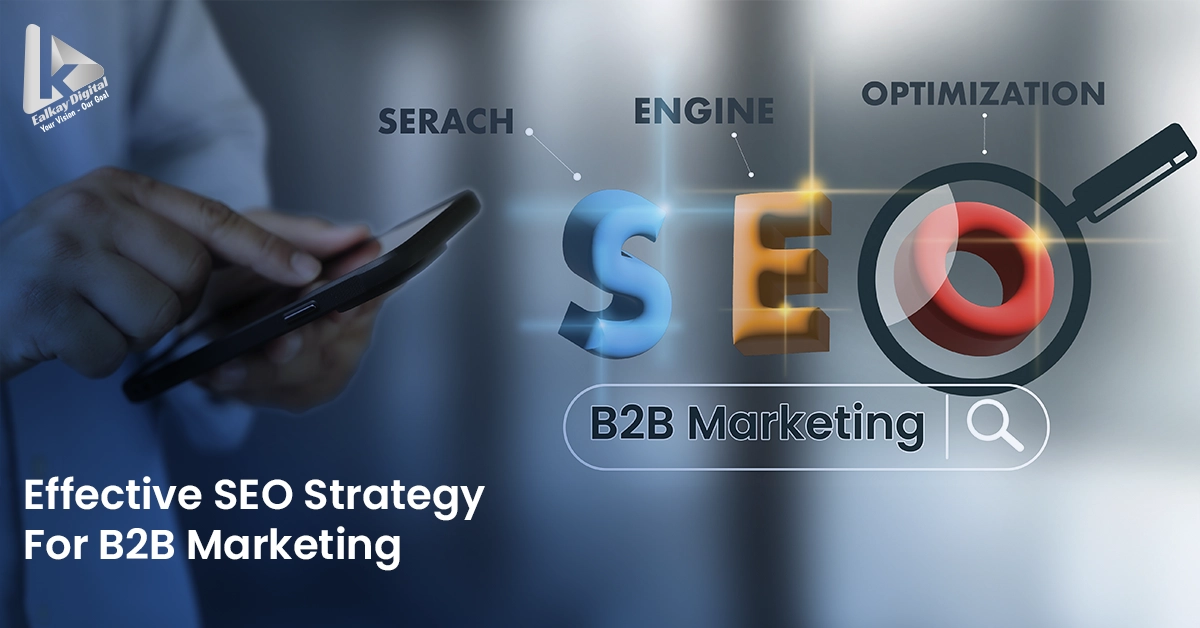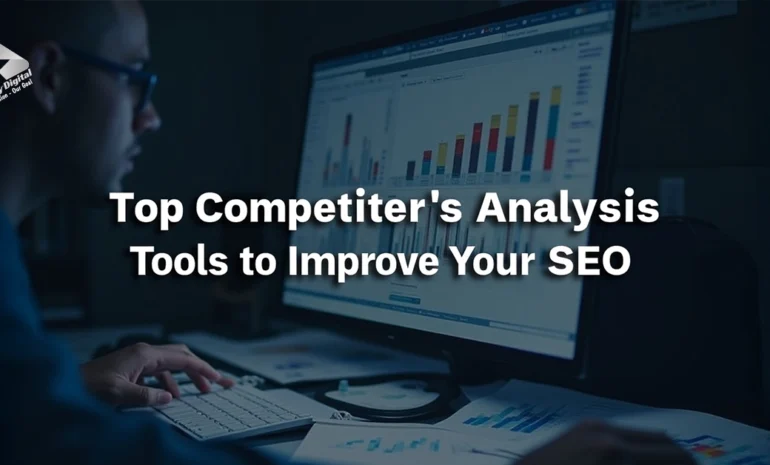Introduction to B2B SEO
B2B SEO, or Business-to-Business Search Engine Optimization, targets decision-makers in other companies to improve search engine rankings for relevant keywords. This strategy drives organic traffic, generates leads, and boosts sales. By focusing on keyword research, content creation, and technical SEO, businesses can enhance online presence, reach their target audience, and stay competitive in B2B markets.
Crafting a Successful SEO Strategy for B2B Marketing
In today’s digital age, crafting successful B2B SEO strategies is crucial for B2B marketing success. An effective B2B SEO strategy goes beyond just ranking on search engines; it’s about understanding and reaching your target audience with precision. At Ealkay Digital, we recognize the unique challenges and opportunities that B2B companies face. Our approach focuses on creating a tailored strategy that aligns with your business goals, ensuring you connect with the right audience at the right time. This blog will guide you through the essential components of a successful B2B SEO strategy, helping your business stand out in a competitive market.
Why Does SEO Matter for B2B Companies?
For B2B companies, SEO is a powerful tool that extends beyond just increasing website traffic. It plays a pivotal role in connecting with B2B audiences by tailoring strategies to meet their specific needs and search behaviors. An effective SEO effort ensures that your brand visibility improves, reaching potential customers at crucial points in their decision-making journey.
Conducting an SEO audit is a foundational step for improving website performance. It involves technical checks for broken links and toxic backlinks, providing actionable insights that enhance a website’s overall visibility in search engine results.
By prioritizing organic traffic through targeted keywords and industry-relevant content, businesses can attract more qualified leads. The cornerstone of B2B SEO success lies in producing high-quality content that not only informs but also engages your audience, ultimately boosting your conversion rate. In essence, SEO is an indispensable part of a B2B strategy that helps establish authority, build trust, and drive business growth.
Understanding B2B vs. B2C SEO Differences
Recognizing the differences between B2B and B2C strategies SEO is vital. B2B marketing demands focused strategies with industry-specific keywords, addressing longer buyer journeys. Unlike B2C, B2B SEO content strategy prioritizes educational content to build authority. This approach meets complex business needs, enhancing audience attraction and conversion success.
Adjusting content strategies to align with the unique needs of B2B markets is crucial for achieving better visibility and engagement in search engine results.

Keyword Volume and Audience Intent
In B2B marketing strategies, understanding search volume and audience intent is crucial. Focusing on low-volume B2B keywords with high search intent ensures better user experiences. Aligning your content with search volumes can enhance your Search Engine Optimization and effectively engage your target audience.
Sales Cycle Variations
In B2B Digital marketing, understanding the sales cycle is crucial as it differs significantly from B2C. This extended cycle requires targeted SEO strategies that address various stages of the buyer’s journey, providing valuable insights to guide potential customers towards conversion. Additionally, it is essential to address multiple decision makers within a company by creating tailored content that resonates with each stakeholder’s unique concerns and pain points.
Understanding Search Intent
Search intent refers to the reason behind a user’s search query. In B2B SEO, understanding search intent is critical to creating content that resonates with the target audience. There are four main types of search intent: informational, navigational, transactional, and commercial.
Informational Intent: Users are looking for information on a particular topic. For example, a search query like “how to improve B2B SEO” indicates that the user wants to learn more about SEO strategies for B2B marketing.
Navigational Intent: Users are trying to find a specific website or webpage. A query like “Ealkay Digital SEO services” shows that the user is looking for a specific service page on the Ealkay Digital website.
Transactional Intent: Users are ready to make a purchase. For instance, “buy B2B SEO tools” indicates that the user is looking to purchase SEO tools for their business.
Commercial Intent: Users are researching products or services with the intention of making a purchase in the future. A query like “best B2B SEO agencies” suggests that the user is comparing different agencies before making a decision.
By understanding search intent, businesses can create content that meets the needs of their target audience and improves their search engine rankings. Tailoring content to match the intent behind search queries ensures that users find the information they need, leading to higher engagement and conversion rates.
Setting Clear Objectives and KPIs to Align with Business Goals
To succeed in B2B search engine optimization, setting clear objectives and KPIs is essential to align with business goals. B2B markets demand a keen focus on search engine rankings and content types. Regularly performing competitor analysis, optimizing for organic search, and conducting technical SEO audits are crucial components of a robust digital marketing strategy to improve click-through rates.
Performing a technical SEO audit is vital to identify critical issues that can be quickly addressed for immediate improvements and to outline a clear and impactful strategy based on the audit findings.
Crafting Comprehensive Buyer Personas: Identifying Target Industries and Mapping Buyer Journeys
Developing detailed buyer personas is key for aligning with target industries and navigating the B2B buying process. By understanding B2B buyers, B2B businesses can refine their focus on ideal customers and target keywords, boosting online visibility. Mapping the buyer journey helps in crafting content that resonates, maximizing organic traffic and effectively engaging the target audience.
Comprehensive Keyword Research: Uncovering High-Intent and Long-Tail Opportunities
To truly excel in B2B marketing, engaging in comprehensive keyword research is vital. This process involves uncovering high-intent and long-tail keyword opportunities that align with your target market. By focusing on relevant keywords that your potential customers use, you enhance your website’s visibility in search engines. Exploring a list of keywords allows you to understand the topics your audience is interested in, which can significantly influence your content performance.
Utilizing tools like Google Ads Keyword Planner and the Keyword Magic Tool to generate keyword ideas is essential for effective B2B SEO. These tools help identify relevant keywords based on search volume and assist in building targeted strategies by aligning content with user queries throughout the marketing funnel.
A solid keyword strategy, supported by regular competitive analysis, can help you adapt to search engine algorithms and improve keyword rankings. By targeting low-volume, high-intent keywords, B2B websites can optimize for specific monthly searches, increasing their relevance and authority in the industry. Key performance indicators play a critical role in measuring success and refining your approach to ensure maximum impact in a competitive marketplace.
Incorporating effective strategies, maintaining optimal keyword density, and building topical authority are crucial for enhancing SEO performance in the B2B sector.
Integrating Keyword Insights into a Content Strategy to Address Pain Points with Content Pillars and Clusters
Integrating keyword insights into a content strategy can effectively address customer pain points by utilizing content pillars and clusters. This refined approach to content optimization is vital for B2B content marketing, as it places emphasis on creating high-quality, informative content that resonates with your audience. By focusing on low-volume keywords, you can strategically enhance your domain authority while offering value through rich snippets and authoritative sources.
Creating a cluster page for each relevant keyword is essential to enhance SEO through better content organization.
Developing a broad yet targeted content marketing strategy involves content creation that ties in closely with content marketing efforts, ensuring that each piece of content is aligned with strategic goals. Promoting valuable content through various channels not only amplifies reach but also solidifies your position as a leader in the industry by covering broad topics relevant to your audience. Through this strategic approach, each piece of content contributes to a cohesive narrative that enhances visibility and impact within competitive B2B markets.
Focusing on Technical SEO for Better Performance
In the pursuit of enhancing B2B marketing through SEO, focusing on technical SEO components lays a solid foundation for better performance. By optimizing elements such as high-quality backlinks and internal links, businesses can effectively boost their visibility in search engines and improve the overall funnel content journey. Reducing bounce rate by offering valuable informational content not only helps retain visitors but also fosters meaningful engagement, crucial for the awareness stage of the buyer’s journey.
One key metric in Google’s Core Web Vitals is cumulative layout shift (CLS), which measures the visual stability of a web page during user interactions. Emphasizing CLS is important for enhancing performance and user experience.
Utilizing tools like Google Search Console can aid in monitoring and refining these efforts for long-term success. Enhancing both Domain Authority and Page Authority through strategic technical SEO practices ensures that your web presence is robust and authoritative, setting the stage for sustained growth and competitiveness in the B2B sector.
Improving Website Loading Times
Improving website loading times is crucial for B2B businesses aiming to enhance visibility in search engines and attract high-quality leads. Faster load times influence user behaviors positively, boosting customer satisfaction and engagement. By using Google Search Console, businesses can optimize for their target audience, ensuring an efficient and effective online presence.
Core Web Vitals are essential metrics that measure user experience on web pages, focusing on how quickly content loads, the responsiveness of the site to user interactions, and the stability of the visual layout during loading. These metrics are integral to Google’s ranking algorithm and are critical for enhancing both SEO performance and user experience.

Ensuring Mobile Responsiveness
Incorporating mobile optimization for web pages is essential for effective B2B search engine optimization. Ensuring mobile responsiveness helps B2B clients access information seamlessly throughout the B2B sales cycle. This enhances decision-making processes, ultimately connecting you with B2B customers efficiently and driving measurable results in a competitive market.
Improving Site Crawlability
Improving site crawlability is vital for enhancing SEO performance and drawing relevant traffic from Google. By ensuring your website is easily navigable, it becomes a reputable destination in the eyes of search engines. A well-structured internal linking strategy is crucial as it enhances organic search engine rankings by establishing the relevance and relationship among different pages on your website. Utilizing Google Search Console allows for optimization at the Consideration Stage, driving authoritative websites through the sales funnel.
Image Optimization
Image optimization is an essential aspect of B2B SEO. It involves optimizing images on a website to improve page load times, increase visibility in search engine results, and enhance the user experience. Here are some key practices for effective image optimization:
Effective image optimization is a vital part of B2B SEO that improves website performance and search engine rankings. Using descriptive file names and alt tags with relevant keywords helps search engines understand image content and boosts organic traffic. Compressing images reduces load times, enhancing user experience and supporting technical SEO efforts like improving cumulative layout shift. Incorporating relevant images aligned with content marketing strategies further engages the target audience and strengthens overall SEO strategies. These practices contribute to higher search engine rankings and better visibility in competitive B2B markets.
By optimizing images, businesses can improve their website’s overall performance and increase their online visibility. Properly optimized images contribute to better search engine rankings and a more user-friendly website.
Implementing On-page SEO Techniques
Implementing on-page SEO techniques with a methodical approach involves using topic clusters and B2B-specific keywords. By diversifying content formats and promoting content effectively, your visibility in search engines improves, thereby boosting search rankings. Creating an own dedicated page for each relevant keyword within a topic enhances SEO through better content organization and user navigation. This provides actionable insights and fosters data-driven decisions, all focused around the primary keyword for optimal impact.
Landing Pages
Landing pages play a crucial role in effective SEO strategies for B2B businesses by serving as targeted entry points that convert organic traffic into leads. Optimizing landing pages with relevant keywords and compelling content helps improve search engine rankings and enhances user experience. Well-designed landing pages align with the sales funnel, addressing specific pain points of the target audience and boosting conversion rates. Incorporating clear calls-to-action and relevant links strengthens the overall B2B SEO strategy, driving qualified traffic and supporting content marketing efforts. Ultimately, optimized landing pages are essential for maximizing website traffic and achieving measurable business growth.
Optimizing Meta Tags and Headers
Optimizing meta tags and headers is essential for enhancing your B2B website’s SEO strategy. Clear, keyword-rich meta descriptions and properly structured headers improve search engine visibility, guiding potential clients through your content seamlessly while boosting click-through rates and engagement for better business outcomes.
Additionally, using image alt text effectively is crucial for helping Google understand the content of images on your webpage, as it cannot interpret images on its own. Providing keyword-focused descriptions or simply describing the image content can significantly improve your SEO.
Meta Descriptions and Search Results
Meta descriptions are short summaries of a webpage’s content that appear in search engine results pages (SERPs). They play a crucial role in B2B SEO as they can influence click-through rates and help users understand the content of a webpage. Here are some tips for crafting effective meta descriptions:
Meta descriptions are concise summaries of a webpage’s content, ideally around 150-160 characters, that include relevant keywords naturally to help search engines understand the page. Crafting unique, descriptive meta descriptions with compelling calls-to-action like “Learn more” or “Get started” encourages users to click and improves search engine rankings. By optimizing meta descriptions, businesses can effectively enhance their SEO efforts, increase website traffic, and better engage their target audience in the competitive B2B market.
By crafting effective meta descriptions, businesses can improve their search engine rankings and drive more traffic to their website. A well-written meta description not only attracts clicks but also sets the right expectations for users.
Creating SEO-Friendly URLs
Creating SEO-friendly URLs involves crafting concise, descriptive URLs that reflect the page’s content and include the target keyword. This enhances both user experience and search engine crawling, making it easier for potential B2B clients to find and engage with your content.
Title Tag Optimization
Title tags are HTML elements that specify the title of a webpage. They are displayed in search engine results pages (SERPs) and play a critical role in B2B SEO. Here are some best practices for optimizing title tags:
Descriptive and Concise: A title tag should accurately describe the content of the webpage and be concise. Aim for around 50-60 characters to ensure it displays fully in search results.
Include Target Keywords: Incorporate relevant keywords naturally within the title tag. This helps search engines understand the content and improves the chances of ranking for those keywords.
Attention-Grabbing: Make the title tag compelling and attention-grabbing to entice users to click through to the webpage. Use action words and highlight the value proposition.
Unique for Each Page: Ensure that each webpage has a unique title tag. This prevents duplicate content issues and provides specific information for each page.
By optimizing title tags, businesses can improve their search engine rankings, increase click-through rates, and drive more traffic to their website. A well-optimized title tag not only attracts clicks but also helps search engines understand the content of the webpage. Effective SEO startegies for B2B businesses are essential to boost organic traffic, improve search engine rankings, and drive qualified leads.
Off-page SEO Strategies: Building Backlinks and Leveraging Social Media for Authority and Visibility
Off-page SEO strategies are crucial in enhancing your B2B marketing by bolstering authority and increasing visibility in search engines. Building natural backlinks through strategic link-building initiatives, such as guest posting, is foundational. By contributing valuable, product-focused content to reputable sites, you can position your brand as an industry thought leader and earn authoritative backlinks. Backlinks from other sites are essential for enhancing SEO and establishing authority, as they serve as endorsements of quality from credible sources. Additionally, leveraging social media platforms can significantly broaden your content’s reach, creating more opportunities for engagement with potential clients at various stages of the B2B sales funnel.
Employing advanced B2B SEO tools and artificial intelligence can streamline this process, helping identify high-impact link opportunities and track performance metrics effectively. Understanding user intent is essential; using keyword research tools to prioritize B2B-specific keywords ensures your brand stays visible and accessible to prospects when they search for your industry or services. Additionally, techniques like fixing broken links are crucial to retain link equity, fortifying your overall SEO strategy.
Measuring Success and Refining Strategy with Google Analytics and Search Console
Measuring success and refining your B2B SEO strategy requires utilizing Google Analytics and Search Console. These analytics tools enhance visibility in search engine results by tracking user engagement and average session duration. Additionally, using helpful tools for analytics and performance tracking can provide deeper insights and improve your strategy. By analyzing data on product-led content and content promotion, you can adjust strategies, attract loyal customers, and maintain a competitive edge throughout the buying journey, unlike B2C keywords.
Conclusion: Elevate Your B2B SEO Strategy with Ealkay Digital
Partnering with Ealkay Digital can elevate your B2B SEO strategy by providing personalized insights and cutting-edge techniques. By leveraging their expertise, your business can achieve higher visibility, attract the right audience, and ultimately drive more conversions in the competitive B2B landscape.





